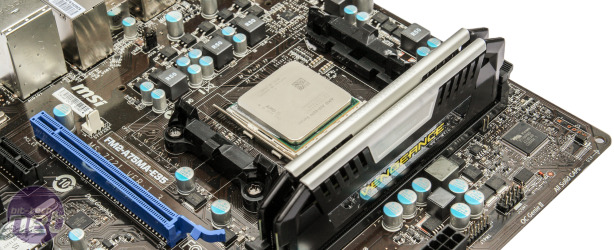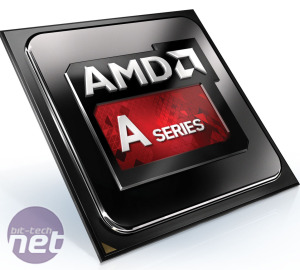Intel Haswell vs AMD Richland - the GPU test
July 2, 2013 | 10:01
Companies: #haswell #intel-and-amd

GPGPU Performance Analysis
Our game tests showed what we expected, with AMD significantly ahead of the Core i7-4770K. It was getting on for twice as fast in Left 4 Dead 2 and managed a 100 per cent improvement on the minimum frame rate in The Elder Scrolls V: Skyrim. While the difference in frames per second was only small in the Unigene Heaven test, in percentage terms, the AMD a10-6800K again held a sizeable lead over the Intel CPU. Meanwhile the Ivy Bridge-based Core i3-3220 was much slower with the Core i7-4770K bettering it by 100 per cent or more.Clearly some of the game benchmarks are still borderline when it comes to playability on the AMD system, but with our tests run at high detail settings, there's plenty of room to reduce the settings a little and still get an enjoyable balance of fidelity and playability. In contrast the Intel APU would require what we would consider an enjoyment-degrading drop in quality to become playable.
Moving onto non-gaming applications, our Handbrake video encoding tests revealed a number of things. Firstly if you have an AMD APU, it's well worth taking a look at the OpenCL beta, which saw the frames per second rise from 36fps with the standard version to 42fps. However there have been a few issues with the recent beta we used and features that are actually accelerated are fairly limited so the advantage isn't as significant as we were expecting. Indeed, the Intel Core i3-3220 beats the AMD A10-6800K, just through sheer CPU power, nulling AMD's APU argument somewhat.
Click to enlarge
Further condemning AMD, in this test at least, is the fact that Handbrake now supports the hardware video encoder/decoder, Quick Sync Video, which is built into both Haswell and Ivy Bridge CPUs. This dedicated bit of hardware annihilates all before it, tripling the speed of AMD's OpenCL accelerated run. The QSV Preset run saw Intel open this lead even further, though the settings for this run are slightly different to our other tests so it's less of a direct comparison.
Putting performance comparisons aside for a moment, it's great to see Handbrake taking these features seriously given how popular it is and we hope we can expect these features to come embedded in the standard version soon.
Given the issues we had with Handbrake, we also ran a few tests in Cyberlink's MediaEspresso too. The hardware acceleration on the AMD CPUs was much more impressive here, with the time taken to encode our video file cut in half when we enabled hardware acceleration with a noticeable improvement over the previous generation APU too. Meanwhile, Intel clearly has hardware acceleration down to a fine art with Quick Sync again providing a massive boost, cutting the time from 82 seconds to just 13 with hardware acceleration enabled.
AMD Dual Graphics Performance Analysis
As for the AMD Dual Graphics testing, it seems little has changed when it comes to dealing with more than one graphics card. The bad news first; Dual Graphics hates Left 4 Dead 2. Strangely we've often seen good results in Valve games in CrossFire testing in the past, however here, the combination of the Radeon HD 6670 1GB and AMD A10-6800K proved to be slower than the same setup with Dual Graphics disabled, or the AMD APU alone. Pairing the Core i3-3220 and the AMD discrete graphics card resulted in the best performance on test, but it only had a small lead over the AMD A10-6800K.
The complete opposite was true in The Elder Scrolls V:Skyrim, which welcomed Dual Graphics with open arms, resulting in the frame rates doubling from using the AMD A10-6800K alone.
As we expected, disabling Dual Graphics and allowing the Radeon HD 6670 1GB to strut its stuff saw a very similar result to the AMD APU on its own, showing that the Radeon HD 8670D under the hood of the A10-6800K is very similar in terms of performance. the Intel setup did prove to be faster than the A10-6800K if you discounted Dual Graphics, but it's clear that when when it works it works well.
Unigene Heaven saw significant boosts too from Dual Graphics, with the minimum frame rate rising from 7fps to 10fps and the maximum frame nearly doubling. Again, the Radeon HD 6670 1GB proved to be the equal of the AMD APU's Radeon HD 8670D graphics, posting the same results when we disabled dual graphics as the A10-6800K on its own.
Conclusion
It's clear that both AMD and Intel have made large strides in GPGPU and gaming performance with their latest round of APUs, making for vastly superior all round performance for both low-end desktops and laptops alike. However, it's equally clear that AMD still holds a significant advantage in terms of raw GPU power. Whether this translates into AMDs chips being worth recommending is a little more subtle though.
While our tests have not been totally comprehensive in terms of covering the world of GPGPU accelerated applications (it's still something of a minefield), the scene has been set, and it shows that although support is out there, there is still a fair amount of variance and that raw CPU power can still count for a lot, putting Intel in the driving seat.
On the flip side, AMD has a big advantage when it comes to gaming, though we do wonder quite how big the market is for such a lowly gaming system.
That said, when we bring things down to brass tacks and look at price, the situation clarifies somewhat. The AMD A10-6800K, despite being AMD's flagship APU, is only £112, which puts it up against Intel Core i3 level chips. We're still waiting for Haswell Core i3 chips but extrapolating from the data we've got, it would seem reasonable to suggest that for CPU power they will be around 10% faster than AMD, while for GPU AMD will around 100% faster. As such the argument for buying an AMD chip for a good all round low-end desktop really does hold up.
Adding in dual-graphics to the mix makes things even clearer. Even accounting for some games/apps not supporting dual-graphics, the performance you'll get in those that do more than justifies the extra £45 or so - you'll get a system that's twice as fast as an equivalently priced one with an Intel CPU. Though it's worth noting that the upgrade path is very limited, with you not getting the advantage of dual-graphics if you were to upgrade to a new £50 card in a couple of years time. Meanwhile to get that sort of performance from a single card you'll need to spend around £80.
Of course, for high-end users the picture is still equally clear. Once above the lowly graphics cards that support dual-graphics (i.e. above that £80 or so) the onboard graphics of AMD's APUs become redundant, leaving only the raw CPU power, and here Intel still has a noticeable advantage in terms of performance/price.

MSI MPG Velox 100R Chassis Review
October 14 2021 | 15:04










Want to comment? Please log in.